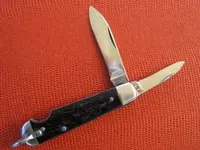Bakelite or jigged bone? Did the knife have two blades? If so and both hinged from the same end then it was a barlow type or trapper, which doesn't tell you much. But neither barlows nor trappers typically have bolsters at both ends the way your knife does.
Better knives had nickel-silver bolsters, and brass liners. Here the bolsters are are totally rusted and the liner looks rusty too, which means it was not a high quality knife -- compatible with being lost at a CCC camp.
With that cut out for opening the blades the knife has a distinctive shape. The specific model and make may be identifiable. This site,
Roseantiquetools, has old catalogs for download, including the Keen Cutter catalog; Keen Cutter had hundreds of models of pocket knife sold at hardware stores. Also, the folks at BladeForum might identify it.
Tell you a story. When I was a tyke in the mid 1950s, a man who was running sheep on the farm [name of Johnny Dobbs, a good man with livestock] leaned on the car while talking to my granddad. To keep me quiet, he whittled a little boat for me while he was standing there talking. I seem to remember he dropped his knife into the stock tank next to the car where I floated the boat. Several years later the metal tank was dry and I found a knife in it, blade extended, covered with rust, blades frozen. I got it and kept it. Maybe 20 years later I soaked the knife in oil and some years after that loosened the rusty blades. Years later in the late 1980s I sanded the rust off the blades so it could be carried and used. Wicked sharp and has good snap! All lettering was gone but from the shape of the longest blade and the distinctive yellow plastic handle, it looks like a Keen Cutter. Your knife is too far gone for use but it still tells a story of lives lived at that camp.








